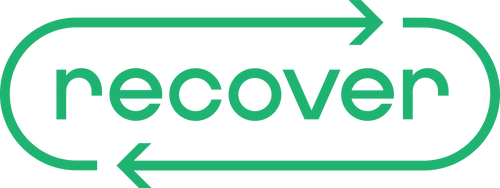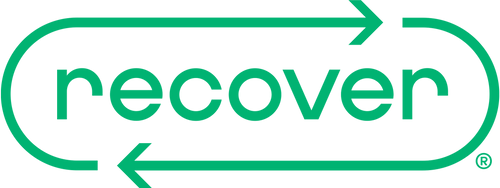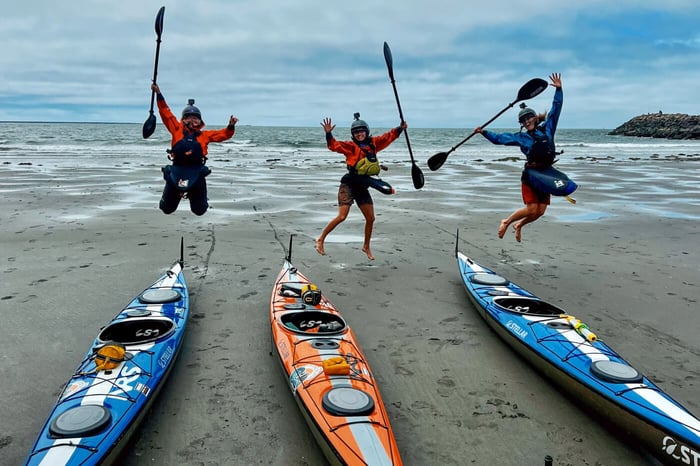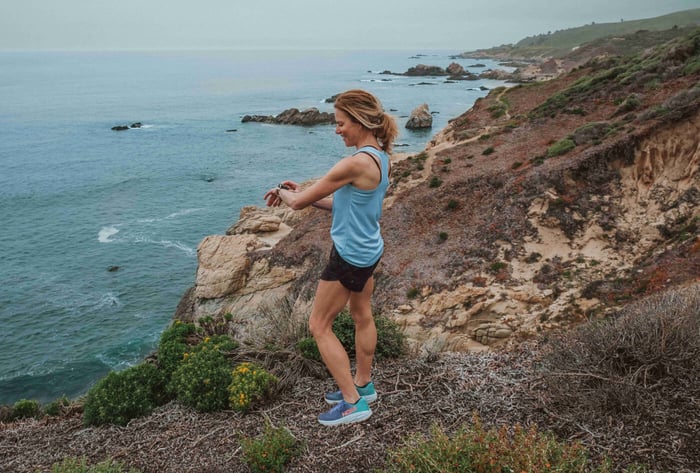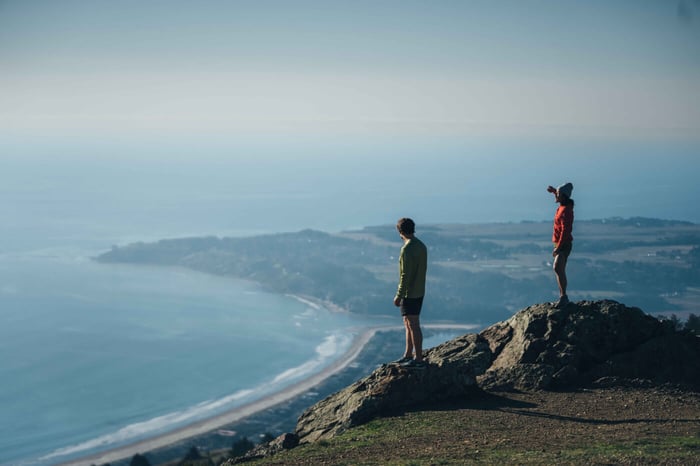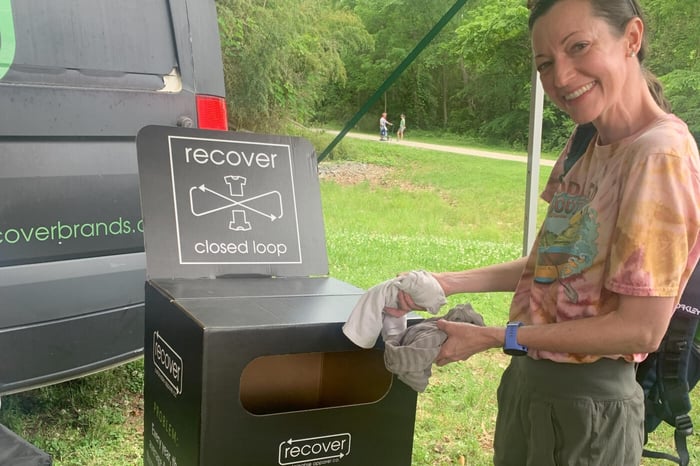3 women, 3 rivers, 3 endangered species of salmon, and 1000+ river miles
Last summer a group of 3 women completed their 1,000-mile paddle from the headwaters of the Salmon River, to the Snake River, and ultimately to the Pacific Ocean. Along the way, they put out a call to action to help dwindling salmon populations, remove the deadbeat dams on the Lower Snake River, and place a moratorium on the proposed Stibnite mine in central Idaho. We caught up with Libby Tobey from the Grand Salmon Source to Sea expedition team to learn more about how she got started on the river and how it led to this epic adventure with a cause.
 Photo: Brooke Hess
Photo: Brooke Hess
Libby, how did the idea for the Grand Salmon Source to Sea start?
I was fortunate to grow up doing river trips with my family. Those trips gave me a personal attachment to rivers at an early age, which eventually led me to river guiding and kayak instructing. My undergrad was in Environmental Science, and I spent the following years working to connect my personal love of areas with academics and watershed science, eventually starting a Masters program at the University of Montana. That’s largely what the Grand Salmon Project grew out of- a shared desire to merge personal, academic, and professional interests. The catalyst for the project was a “conversation” between myself and Brooke Hess while we were topo duo-ing [paddling a two person whitewater kayak] on the Lochsa, simultaneously screaming and having the time of our lives. Somehow, in the breaks between rapids, we got to talking about the idea of a giant, advocacy-centered kayaking trip once we both finished grad school (Brooke was about to enroll in a Masters of Science Journalism program at the time). Rivers and river trips are a unique hook to get people involved in conservation, and this idea became the backbone of the project as it emerged over two whole years– with an immense amount of support from the whitewater community, nonprofit organizations, and industry partners.
 Photo: Brooke Hess
Photo: Brooke Hess
What was the premise of the Grand Salmon Source to Sea?
The source to sea itself was a physical expedition of around 1,000 river miles that started from the headwaters of both the Middle Fork Salmon and Main Salmon in central Idaho. Our vision was to start from the highest point in the watersheds and then follow the outmigration of juvenile salmon towards the Pacific Ocean. We felt that a source to sea expedition would give us a unique perspective on a watershed we all love deeply, giving us a firsthand window into one of the most pressing threats it faces today.
Anyone familiar with the Snake River basin (of which Idaho’s Salmon River is a tributary) has likely heard about the drastic declines in the basin’s wild salmon populations. Salmon used to return by the millions to spawn throughout the Snake River watershed, however these numbers have dwindled to a small fraction of their historical size, leaving many salmon species facing extinction. Salmon are a keystone species, providing both an ecological backbone and a cultural centerpiece to the Tribes that traditionally subsisted on them. Although many factors have contributed to this decline, one factor dwarfs the rest: large-scale hydropower development. Speaking with fish biologists familiar with the region, the 4 Lower Snake River dams are considered the greatest current threat to Snake River Basin salmon migration and survival, and today, proposals to breach the dams have gained increasing popular and political traction. In many ways, the dams longer make sense: they provide certain benefits like facilitating river-based shipping and providing a limited supply of hydropower, but economically speaking, the dams are heavily subsidized and no longer represent a net benefit. The fight for a free-flowing Snake River has been ongoing since the dams were erected, an unwavering resistance led by the region’s Tribal nations. In undertaking the Grand Salmon project, we wanted to focus attention on these once-thriving salmon populations which today are hanging by a thread, threatening communities and ecosystems from the mountains to the ocean. We saw the project as an opportunity to use our strange sport to highlight an issue on a collision course with the rivers we love. If you breach the Lower Snake River dams, you give the basin’s salmon a chance of survival– and the watershed as a whole a chance to bounce back. We couldn’t pass up the chance to do our small part.
And what is the proposed Stibnite mine in Idaho that the project called out for needed action?
The Stibnite Mine is a proposed gold mine, located in the headwaters of the East Fork of the South Fork of the Salmon River in Idaho. The current Stibnite proposal seeks to reopen a discontinued mining effort which, due to the environmental contamination it caused, was ultimately designated as a Superfund site and is still undergoing active remediation. The reopened mine would threaten invaluable fish habitat and recreation in the South Fork Salmon watershed, as well as the health of adjacent communities. We all need and use the minerals produced by mining efforts, but the tradeoffs of mining have to be weighed carefully. The Stibnite Mine, as proposed, poses an unacceptable threat to one of the best remaining habitats for Snake River Basin salmon. If the Lower Snake River dams are removed and salmon are given the opportunity to return to headwaters, what good will those efforts do if a massive, polluting gold mine is established in their reopened habitat?

Photo: Brooke Hess
How was the expedition?
It was a wild trip; one we’ll all look back on with some kind of disbelief for a lifetime. It took two and a half months to paddle from the headwaters of the Salmon and down the Lower Snake and Columbia Rivers to the Pacific Ocean. After the confluence of the Salmon and Snake Rivers, the paddling gets flatter, so we switched to sea kayaks to be able to make more miles. The challenges of each section were incredibly different, from blizzards in the high country to dodging 800 foot cargo ships on the Columbia, but simply having the chance to watch the landscape change as we paddled was one of the most awe-inspiring experiences I’ve ever had. Along the way, we held a number of public outreach and engagement events. The purpose of this was two-fold: first, we wanted to get this cause on the radar of people who were not aware of it, and second, we wanted to hear people’s stories about rivers and salmon– including those that didn’t align with ours, as many people believe the dams should remain in place. We got lucky on timing, and the trip coincided with a large number of state and federal actions regarding the dams. This meant we had lots of opportunities to help communities take action (like making public comments or writing letters to Congress) at key moments. We also were able to help support people to write letters on the issues to key members of congress and the Biden administration and learn about the public process.
 Photo: Libby Tobey
Photo: Libby Tobey
And finally, it’s impossible to discuss the expedition without talking about the incredible amount of support we received from the project’s inception to the day we paddled into the Pacific Ocean. I can’t give enough thanks to our primary conservation and logistical partners, Idaho Rivers United and Rivers for Change. But there were also countless other contributors to this project, from our friends and families to the numerous nonprofit organizations and industry sponsors that supported us along the way, and are still doing so today. To all those incredible people, we are massively grateful.

Photo: Brooke Hess
Why did the Grand Salmon Source to Sea partner with Recover?
We chose Recover because of a team decision that felt like a no-brainer to us: we wanted to partner with an environmentally conscious company to design the project merch. When our incredible industry partner and sponsor NRS said; “we’re using those guys–” that was more than good enough for us!
What else?
This project was important to us because while there are so many whitewater paddling films that focus on paddling itself, we all wanted a chance to make this project and the sport of kayaking contribute to something slightly greater. To our team, it felt like giving back a little to our rivers, our sport, and the whitewater community that has done so much for us. We are stoked beyond belief at how this project turned out, thrilled about the Grand Salmon film that’s currently in production, and intent on continuing with this kind of work in the future.

Photo: Hailey Thompson
